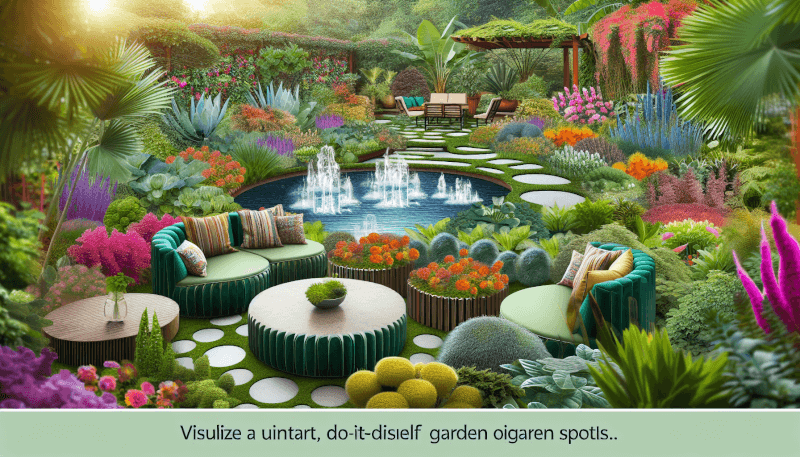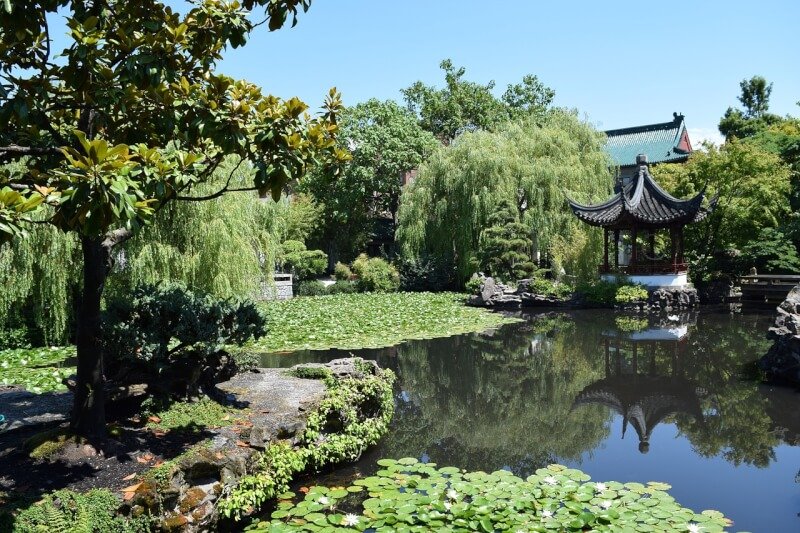Imagine stepping outside into your own personal paradise, a serene garden oasis that you created with your own two hands. With just a few simple steps, you can transform your outdoor space into a tranquil retreat that you can escape to anytime. In this article, you will discover the secrets to creating a beautiful DIY garden oasis that will not only enhance the beauty of your home but also provide a peaceful sanctuary for relaxation and rejuvenation. Get ready to uncover the tips and tricks that will turn your garden into the envy of the neighborhood.
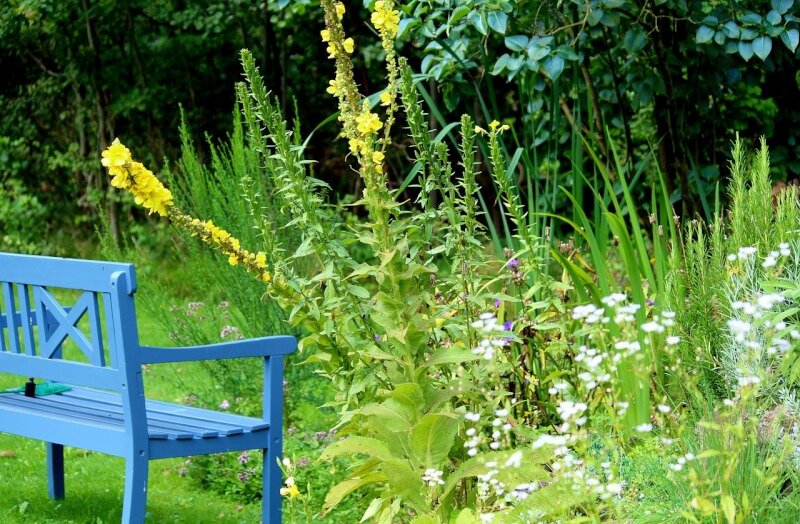
Choose the Ideal Location for Your Garden Oasis
Creating a garden oasis is an exciting project that allows you to create a tranquil retreat right in your own backyard. Before you dive into designing and planting, it’s crucial to choose the ideal location for your garden oasis. Here are a few factors to consider:
Assess the sunlight and shade levels
Observe the sunlight and shade patterns in your yard throughout the day. Most plants require at least six hours of direct sunlight to thrive, so it’s essential to choose a spot that receives adequate sunlight. Avoid areas that are heavily shaded by buildings or trees, as this can limit plant growth and flower production.
Consider the proximity to water source
Water is essential for the health and growth of your plants, so it’s important to choose a location that is close to a water source. This will make watering your garden more convenient and efficient. Consider the accessibility of a hose or irrigation system when determining the ideal location.
Evaluate the soil quality
Take a closer look at the soil in your yard. Is it sandy, clay-like, or loamy? Most plants prefer well-draining soil that is rich in organic matter. If your soil is lacking in nutrient content, you may need to amend it with compost or other organic materials. Assessing the soil quality will help you determine if any soil preparations need to be made before planting.
Design Your Garden Layout
Once you’ve chosen the ideal location for your garden oasis, it’s time to design the layout. A well-thought-out design will ensure that your garden is both aesthetically pleasing and functional. Follow these steps to create a beautiful garden layout:
Sketch your garden design
Grab a pen and paper and start sketching your dream garden oasis. Consider the dimensions of your space and any existing features such as trees or fences. Think about the overall shape and flow of your garden, keeping in mind any focal points or desired areas for seating.
Plan the pathways and seating areas
Pathways and seating areas are essential elements that contribute to the overall functionality of your garden oasis. Plan the placement of pathways, making sure they are wide enough to comfortably walk on. Consider adding seating areas where you and your guests can relax and enjoy the beauty of your garden.
Consider the focal points and plant beds
Focal points and plant beds add visual interest and create a sense of structure in your garden. Identify areas where you want to draw attention, such as a beautiful tree or a vibrant flower bed. Arrange your plant beds strategically, making sure to consider height, color, and texture to create a visually appealing garden oasis.
Select the Perfect Plants
Now that you have your garden layout in place, it’s time to select the perfect plants for your garden oasis. Choosing the right plants will ensure that your garden thrives and remains beautiful throughout the seasons. Follow these steps to select the perfect plants:
Identify your gardening zone
Understanding your gardening zone is crucial in selecting plants that will thrive in your specific climate. Every plant has a preferred hardiness zone, which indicates the optimal temperature range for growth. Consult a hardiness zone map to determine your zone and choose plants accordingly.
Choose suitable plants for your climate
Once you know your gardening zone, research plants that are well-suited to your climate. Consider factors such as temperature, rainfall, and humidity when selecting plants. Native plants are often a great choice as they are adapted to the local conditions and require less maintenance.
Select a variety of perennial and annual plants
To create a garden oasis that blooms throughout the year, choose a combination of perennial and annual plants. Perennials are plants that come back year after year, while annuals complete their life cycle within one year. Mixing these two types of plants will provide continuous color and variety in your garden.
Prepare the Soil
Before you start planting, it’s important to prepare the soil to provide the best growing conditions for your plants. Follow these steps to prepare the soil effectively:
Clear the area of debris
Remove any debris such as fallen leaves, rocks, or branches from the area where you plan to plant. This will create a clean and tidy space for your garden oasis.
Remove any weeds or grass
Weeds and grass compete with your plants for nutrients and space, so it’s crucial to remove them before planting. Pull out any weeds by hand or use a garden tool to eliminate them. If you have a persistent weed problem, consider using an herbicide, taking care to follow the instructions carefully.
Loosen the soil and amend it with compost
Loosen the soil using a garden fork or tiller. This will improve drainage and allow plant roots to penetrate easily. Additionally, incorporate compost into the soil to improve its structure and fertility. Compost adds valuable nutrients and organic matter, creating a healthy environment for your plants to thrive.
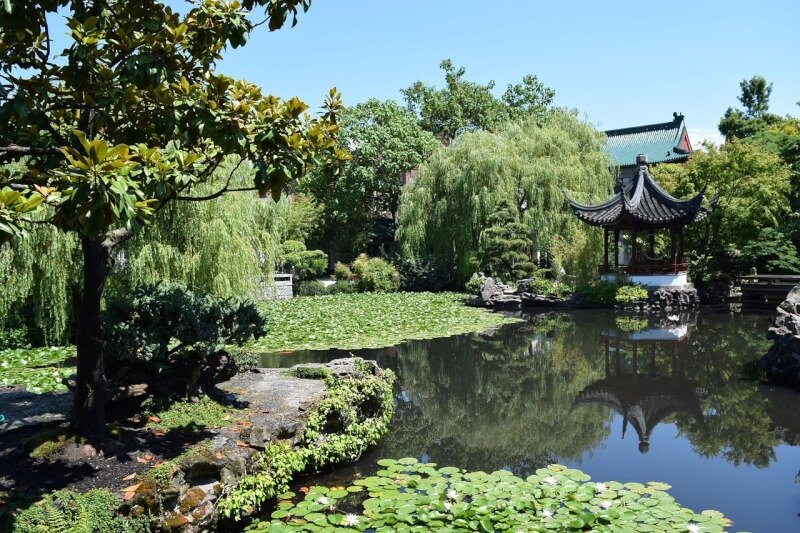
Install Hardscaping Elements
Hardscaping elements are the non-living features that add structure and functionality to your garden oasis. They can include pathways, retaining walls, seating areas, and decorative elements. Consider incorporating the following hardscaping elements:
Lay down a pathway using pavers or gravel
Pathways not only provide a functional purpose but also add aesthetic appeal to your garden. Lay down a pathway using pavers, gravel, or stepping stones, depending on your preference and the overall theme of your garden oasis. Ensure that the pathway is wide enough for comfortable walking and consider using materials that complement the surrounding plants and features.
Add retaining walls or raised beds
If your yard has slopes or uneven terrain, consider adding retaining walls or raised beds to create level planting areas. Retaining walls provide structure and help prevent soil erosion, while raised beds elevate plants for better drainage and improved visibility. These elements can add depth and dimension to your garden oasis.
Incorporate a seating area or pergola
A garden oasis is a place where you can relax and unwind, so it’s important to incorporate a seating area or pergola into your design. Choose comfortable outdoor furniture that suits your style and create a cozy corner where you can enjoy your garden. Alternatively, a pergola can provide shade and serve as a focal point in your garden.
Plant Your Garden
Now comes the exciting part – it’s time to plant your garden oasis! Follow these steps to ensure a successful planting process:
Start by planting trees and shrubs
Trees and shrubs form the backbone of your garden oasis, providing height, structure, and shade. Start by planting these larger plants, considering their mature size and spacing requirements. Be sure to dig large enough planting holes and backfill with soil, ensuring that the root ball is covered.
Follow with the placement of flowers and perennials
Once your trees and shrubs are in place, move on to the placement of flowers and perennials. Consider the heights, colors, and bloom times of these plants to create a visually pleasing arrangement. Arrange them according to your garden design, keeping in mind the focal points and beds you established earlier.
Create visual interest with varying heights and colors
To create a garden oasis that is visually appealing, incorporate plants with varying heights and colors. This will add depth and dimension to your garden, making it more interesting to look at. Consider using tall, medium, and low-growing plants to create layers and balance in your garden design.
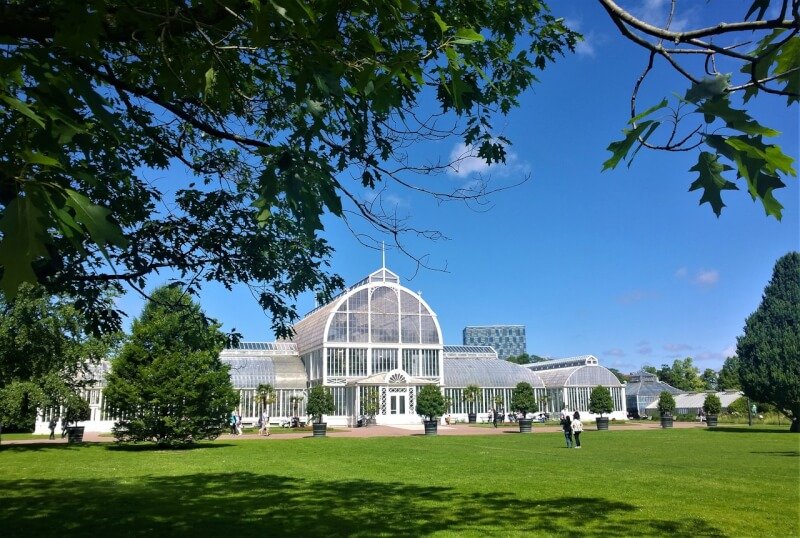
Add Functional and Decorative Features
To truly transform your garden into a peaceful oasis, add functional and decorative features that enhance its beauty. Here are a few ideas to consider:
Install a water feature like a fountain or pond
The soothing sound of water can enhance the peaceful ambiance of your garden oasis. Consider installing a water feature such as a fountain or pond. This will not only create a focal point but also attract birds and other wildlife to your garden.
Include garden lighting for ambiance
Extend the enjoyment of your garden oasis into the evening hours by incorporating outdoor lighting. Strategically placed lights can highlight focal points, illuminate pathways for safety, and create a magical ambiance. Choose soft, warm lighting options to create a cozy and inviting atmosphere.
Add decorative elements such as statues or trellises
Decorative elements can add personality and charm to your garden oasis. Consider incorporating statues, trellises, or decorative planters. These elements can serve as focal points or provide support for climbing plants, adding vertical interest to your garden.
Implement Practical Garden Maintenance
To ensure that your garden oasis remains beautiful and thriving, implement practical garden maintenance practices. Here’s how you can keep your garden in top shape:
Establish a watering and fertilizing schedule
Proper watering and fertilizing are essential for the health and growth of your plants. Establish a watering schedule that takes into account the needs of each plant and the climate in your area. Similarly, provide regular fertilization to replenish nutrients in the soil. Follow recommended guidelines for each type of plant and fertilizer to prevent over or underfeeding.
Regularly prune and trim plants
Pruning and trimming are necessary to maintain the shape and health of your plants. Remove dead or diseased branches, and shape plants according to your desired aesthetic. Regularly check for signs of pests or diseases and take appropriate action to prevent their spread.
Mulch the beds to retain moisture and prevent weeds
Applying mulch to your garden beds offers several benefits. Mulch helps retain moisture in the soil, reducing the frequency of watering. It also acts as a natural weed barrier, suppressing weed growth and minimizing the need for manual weed removal. Apply a layer of organic mulch around your plants, taking care to avoid direct contact with the stems.
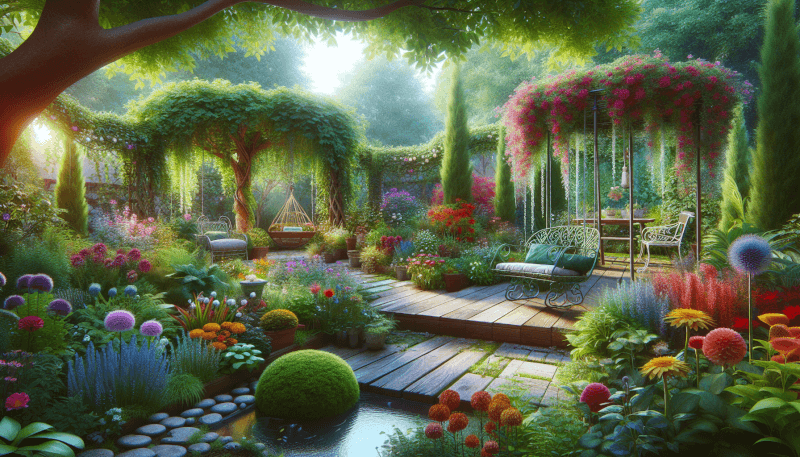
Attract Wildlife to Your Garden Oasis
Transform your garden oasis into a haven for wildlife by implementing features that attract birds, butterflies, and other pollinators. Here’s how you can create a wildlife-friendly garden:
Plant native flowers to attract pollinators
Native flowers are a magnet for pollinators such as bees and butterflies. Research which native plants are suitable for your area and incorporate them into your garden. Choose a variety of flowering plants that bloom throughout the seasons to provide a continuous food source for pollinators.
Provide bird feeders or birdhouses
Birds add a delightful element to any garden. Install bird feeders or birdhouses to attract a wide variety of bird species. Choose feeders that are suitable for the types of birds you want to attract and position them in a safe and easily accessible location.
Create a small wildlife habitat with water and shelter
Enhance the wildlife-friendly aspect of your garden oasis by creating a small wildlife habitat. Install a birdbath, small pond, or shallow dish of water to provide a water source for birds and other creatures. Additionally, incorporate natural shelter elements such as shrubs, trees, or a brush pile to provide cover and nesting spots.
Enjoy and Maintain Your Garden Oasis
Now that your garden oasis is complete, it’s time to sit back, relax, and enjoy the fruits of your labor. Remember to maintain your garden regularly to keep it looking its best. Here’s how you can enjoy and maintain your garden oasis:
Create a cozy seating area to relax and admire the garden
Set up a comfortable seating area where you can relax and take in the beauty of your garden oasis. This could be a simple bench, a hammock, or a patio set. Position your seating area strategically to maximize the enjoyment of the surrounding plants and features.
Regularly maintain the garden by weeding and deadheading
Maintaining your garden oasis requires ongoing care. Regularly weed your garden to prevent unwanted plants from competing with your desired plants. Additionally, deadhead flowers – i.e., remove spent blooms – to encourage continuous blooming and overall tidiness.
Invite friends and family to enjoy the space
Your garden oasis is meant to be shared and enjoyed with loved ones. Invite friends and family over to experience the tranquility and beauty of your creation. It’s a wonderful way to create lasting memories and inspire others to embark on their own gardening adventures.
Creating a beautiful DIY garden oasis is a rewarding endeavor that allows you to design and create a space that brings joy and tranquility. By carefully choosing the location, designing the layout, selecting suitable plants, and implementing maintenance practices, you can create a garden oasis that is not only visually stunning but also a haven for wildlife and a place for relaxation and enjoyment. So grab your gardening tools, get creative, and start building your dream garden oasis today!
